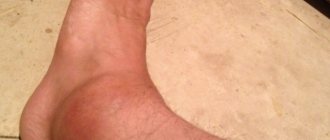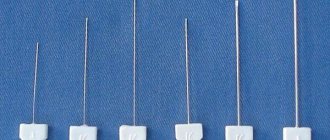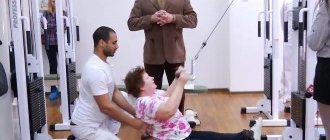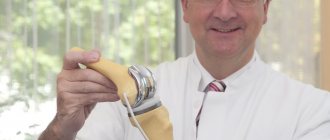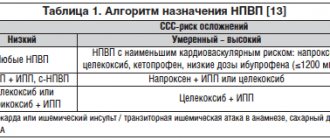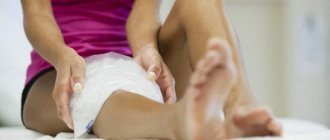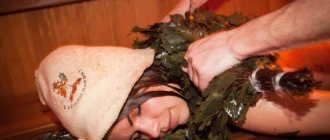Articulating knee spacer
The utility model relates to medicine, namely to traumatology and orthopedics, and can be used in the manufacture of knee joint spacers.
The articulating spacer of the knee joint has a femoral component equipped with a thin-walled insert made of nanoceramic porous biocompatible material, repeating the geometry of the articulation with the tibial component and having ruff-type fastening protrusions on the reverse side, and the tibial component has recesses up to 12 mm, corresponding to the thickness of the insert.
Known are temporary therapeutic molded endoprostheses (spacers) used for infectious complications of total knee arthroplasty after removal of both components of the endoprosthesis (COMPARISON OF ARTICULATING VERSUS STATIC ANTIBIOTIC LADEN CEMENT SPACERS IN TWO-STAGED KNEE REVISION ARTHROPLASTY FOR SEPSIS / Jagiello, JM et all. //Proceedings to 2007 EFORT Florence).
The disadvantages of such spacers are the low strength characteristics of the material used, a decrease in the range of motion in the knee joint due to significant friction in the polymer-polymer pair.
Cement spacers are known, in which CoCr pads impregnated into the condylar parts are used to increase the strength of the femoral component and reduce friction (The PROSTALAC functional spacer in two-stage revision for infected knee replacements /Fares S. Haddad et all // J. Bone Joint Surgery [Br] 2000;82-B:807-12).
The disadvantage of such spacers is wear in the metal-polymethyl methacrylate friction pair, caused by a significant difference in the strength properties of the mating components.
The purpose of the utility model is to increase the strength and wear resistance of the spacer components and increase the range of motion in the knee joint.
The problem is solved by the fact that the articulating surface of the femoral component of the spacer is equipped with a thin-walled insert made of nanoceramic porous material, repeating the geometry of the articulation with the tibial component and having ruff-type fastening protrusions on the reverse side, and the tibial component of the spacer has recesses up to 12 mm corresponding to the thickness of the nanoceramic liner.
Figure 1 shows the femoral component of the spacer, Figure 2 shows the tibial component of the spacer, Figure 3 shows nanoceramic inserts for the femoral component of the endoprosthesis, where: 1 - articulating surfaces of the femoral component; 2 - tibial component; 3 — nanoceramic inserts; 4—protrusions-fastenings of the “ruff” type.
The device is used as follows.
The articulating surfaces 1 of the femoral component of the spacer are reinforced with nanoceramic liners made on the basis of partially stabilized zirconium dioxide (ZrO2(Y2O3) or ultrafine aluminum oxide, composite material AL2O3/ZrO2, repeating the geometry of the articulation with the tibial component 3 and having protrusions-mounts on the reverse side of the "type" ruff" 4, and the tibial component 2 of the spacer has recesses of up to 12 mm corresponding to the thickness of the nanoceramic liner.
The coefficient of friction pair of nanoceramics-cement is 1.6-2.3 times less than the coefficient of friction of the pair of cement-cement, which leads to a significant reduction in the effort expended by the patient on movements in the knee joint, and, consequently, an increase in the amplitude of movements in it . The strength of nanoceramics is 2.5-2.8 times greater than the strength of cement, which significantly reduces the likelihood of destruction of the spacer components. The materials used to make the liner are biocompatible and bioinert.
An articulating spacer of the knee joint containing femoral and tibial components, characterized in that the femoral component is equipped with a thin-walled insert made of nanoceramic porous biocompatible material, repeating the geometry of the articulation with the tibial component, and the tibial component has recesses of up to 12 mm, corresponding to the thickness of the insert.
Inhalation spacer for children: instructions
Algorithm for inhalation with spacer for children:
- Before use, you should also prepare the can and check the spacer for damage.
- A suitable size mask must be attached to the device. Then put it on the child and ask him to secure it tightly.
- Each action should be controlled and guided by instructions that the child can understand. It is useful to present the procedure in a playful way. If the child is middle-aged, then he can press the valve himself and inhale; small children should do this on their own. The inhalation should be calm.
- When finished, you need to disassemble and wash.
The device must be individual for the child.
For the second inhalation you need to pause for 30 seconds.
Precautionary measures
To ensure the procedure is safe, you need to follow simple precautions:
- check the expiration date of medications;
- reprocess the spacer regularly;
- check the device for damage and leaks;
- use children's devices, mask sizes;
- explain to the child the essence of the procedure;
- monitor the appearance of cough, shortness of breath, choking and interrupt inhalation if necessary;
- before the procedure, do not give food and drinks, and also limit active games;
- after inhalation, refrain from eating and drinking liquids for half an hour;
- do not go out into cold air after the procedure;
- monitor the child’s condition between inhalations for signs of allergy: changes in skin color, breathing rhythm;
- use medications strictly according to instructions.
Features of types of orthoses for knee joints, indications and correct choice
Revision arthroplasty is a surgical intervention to remove the installed knee joint endoprosthesis and put a new one in its place. The operation is performed due to the instability of the implant. Revision interventions are performed in 8-10% of patients after primary surgery.
Renten after the initial operation. The implant is positioned correctly.
After installation of an oncological endoprosthesis, about 30% of patients require revision surgery. Organ-sparing treatment of tumors is more often accompanied by complications than conventional joint replacement.
Revision knee replacement surgery takes much longer than regular knee replacement surgery. This increases the risk of developing infectious, thromboembolic and other complications.
A removed endoprosthetic component due to wear.
The cost of repeated replacement, in the case of aseptic instability, it increases by 25-100%, and with the development of periprosthetic infection - by as much as 3-4 times. Prices for revision endoprostheses are also slightly higher than for regular ones.
All contraindications to reoperation are divided into absolute and relative. If the former are present, surgical intervention is prohibited, as this can lead to serious complications.
- the patient's inability to move independently;
- hemiparesis on the side of the planned surgical intervention;
- acute or worsened thrombophlebitis;
- severe chronic diseases of the cardiovascular system;
- respiratory failure stage 3;
- the presence of unsanitized foci of chronic infection in the body;
- severe osteopenia;
- serious mental or neuromuscular disorders;
- absence of the medullary canal of the femur.
Relative contraindications include liver failure, severe chronic decompensated diseases, hormonal osteopathy and HIV-associated immunodeficiency conditions.
Spacer for inhalation: price, where to buy
A spacer for inhalation can be purchased in pharmacies and medical equipment stores; the price depends on the manufacturer and pharmacy chain. You can also order devices online. In Moscow, delivery within the city and region is widely available, as well as orders from other cities and countries.
| Spacer | Price |
| Pari Vortex | 1200-1500 rubles |
| OptiChamber Diamond | 900-1000 rubles |
| AeroChamber | 1400-1700 rubles |
| Air Liquide Lespace | 1600-2000 rubles |
| Free-breath Baby flow | 600-800 rubles |
| AeroChamber Plus | 940-1350 rubles |
Knee brace
World and domestic medicine has stepped far forward. Nowadays, even the most complex injuries and damage to the knee joints are successfully treated and do not pose a threat to the health and life of the patient. Not only drug treatment is successfully practiced, but also the use of various orthopedic devices.
Joint fixators can be anything (bandage, elastic bandage, orthosis), but the most popular today is a special brace device for joints.
This device not only holds the affected knee joint, but is also capable of providing therapeutic, restorative, corrective and unloading effects.
A knee brace is a specific type of knee brace. It is made from a special material neoprene (foam rubber), reinforced on the sides with hinges and stiffeners.
Doctors use this device instead of a standard plaster cast if there is a need to immobilize an injured joint for several weeks. For example, this is necessary after knee surgery.
In addition, wearing a brace is important in the following cases:
- recovery after diagnostic, therapeutic arthroscopy;
- rehabilitation after injury;
- if the ligamentous apparatus is incompetent;
- for osteochondropathy, osteoarthrosis, hemophilitic hemarthrosis.
- rehabilitation after knee surgery.
The main advantage of the brace is the ability to independently adjust the range of flexion of the fixed limb. At the same time, the fixation can be loosened, which allows the patient to perform physical therapy exercises without overloading the joints.
The design of the brace involves polycentric locks that fix the knee in the required position. Usually we are talking about sectors of 10, 20, 40, 60, 90 or 150 degrees.
In specialized medical literature and online sites you can find many descriptions of the effectiveness of using a brace. However, actual clinical experience rather than mere empirical speculation deserves special attention. For example, researchers from America created an accurate model of a human leg to analyze the effectiveness of the device.
The materials for the dummy were polyurethane and elastic latex. In the places where a person’s menisci are located, special drives were installed, and sensors were placed in the area of maximum compression loads, allowing them to immediately receive a dynamic response after various impacts.
The study found that wearing a brace does significantly reduce valgus displacement. This makes the device an indispensable working mechanism for eliminating congenital diseases and contractures.
Moreover, it has been found that a custom-made knee brace is several times more effective than a standard one.
Thus, the use of a standard brace, for example model nkn 555, is only sufficient to eliminate:
- post-traumatic consequences;
- postoperative complications.
Types of braces
There are 4 main types of joint braces:
- preventive. Necessary to protect knees from injury (during contact sports);
- functional. Provide support for injured knees;
- restorative. They provide for limiting harmful movements of the knee joint, allowing it to heal faster;
- patellofemoral. Designed to help the kneecap move smoothly in the joint.
The majority of patients who have already used the brace noted high efficiency and rapid recovery. The most popular model should be called nkn 555.
A knee brace is the support needed for an injured or painful knee joint. Some people, especially those who lead an active lifestyle, use braces to prevent injury during physical activity.
High-quality models are made from various combinations of tape, elastic material, metal, plastic and foam. Moreover, the products differ in type of design, size and even color.
It is necessary to use a knee brace in the following cases:
- knee surgery took place;
- rehabilitation and development of the knee joint after a dislocation;
- with stiffness.
It may seem that the brace device is complicated. However, this is not the case and the patient himself can put it on. Thanks to special polycentric fasteners, locks, and stretch straps, the fixator is perfectly attached to the affected limb and reliably holds it in the required position.
Ankle joint devices are made of non-stretchable medical grade plastic. It is flexible, but at the same time securely fixes the affected area of the leg.
In addition, the brace has a shock-absorbing cotton-based lining, 2 sewn-in non-removable springs with a spiral, covering the contour of the ankle in a U-shaped pocket. This allows you to fix the distal parts of the tibia and relieve excessive stress on the fibular and deltoid ligaments.
Additionally, a lacing fixation is provided to hold the syndesmosis (interfibular) ligament. A device is needed to fix the ankle joint and the distal third of the leg in the frontal plane, to provide limited fixation of the foot.
Types, recommendations for selection
Spacers vary in type depending on their size (children’s and adults) and some details of the device - with masks, universal, children’s, one- and two-valve. The choice of the appropriate option is determined by the condition of the respiratory tract, age, drug and its form. You should consult your doctor before purchasing the device.
With mask for children
Devices with a mask are best for children and come in different sizes depending on the age of the child. Using a mask allows the baby to easily inhale the drug without unnecessary effort, and it also makes the procedure easier emotionally.
Bright and colorful devices are produced for children to attract the child’s attention to the procedure and make it more exciting. It is useful to choose a device with a collapsible chamber for ease of processing. Spacers are classified:
- with masks for babies from 0-2 years;
- with masks for children 2-6 years old;
- with masks for children over 6 years old;
- spacers for adults;
- device without a mask with a mouthpiece.
After several inhalations, the device should be washed and treated with antiseptics.
The spacer for a child must be individual. For older children, devices with a 350 ml chamber are well suited, but for small children it is better to choose a spacer in the range of 150-200.
Universal
The universal version has a similar design: two cone-shaped parts made of plastic - a chamber with a mouthpiece and a chamber with a hole for the inhaler. This device has an average chamber volume of 350 ml. A mask may be included.
Often these spacers do not have valves. They are suitable for the treatment of adults with chronic pathology. For weakened patients, it is better to choose another option - with a mask and valves.
By number of valves
Modern models have valves for inhalation and exhalation. Such improvements allow for better coordination of respiratory flows. Spacers are divided into one- and two-valve models. The latter option is suitable for diseases requiring high doses of drugs, as well as for people prone to allergic reactions. This separation of air contributes to a more accurate delivery of the drug dose into the respiratory tract, reducing dispersion and mixing of the drug.
Dimensions
By size, spacers are divided into children's and adult, as well as large for patients with seizures and standard for daily use. The volume of the mask can be 100, 150 and 350 ml.
Dosage regimen
The dosage regimen in the devices can vary from a minimum to a maximum dose. Typically, 1 inhalation of the medicinal substance is taken per inhalation. To relieve bronchospasm attacks, take 2-3 breaths in a calm mode.
During the day, medications are used with a break of 2 to 12 hours, depending on the duration of action of the drug. 2 doses of the medicine in a row require a short break of 30-60 seconds. If the patient is weakened, then slowly inhaling one dose over half a minute is possible.
The standard regimen for taking the drug includes its course use with monitoring of effectiveness and tolerability. High doses of drugs are usually prescribed several times a day.
Popular models, their pros and cons
Some of the most popular are the following models:
- Pari Vortex;
- Philips Respironics OptiChamber Diamond;
- AeroChamber;
- Air Liquide L espace;
- Free-breath Baby flow;
- AeroChamber Plus.
They differ in materials of manufacture, volumes, purpose, presence of a sound signal and some additional options.
Free-breath Baby flow
Free-breath Baby Flow is of high quality and a reasonable price of 670 rubles. The country of manufacture of the spacer is China. The device is specially designed for use by children under 5 years of age. He has 3 masks to choose from in size: small, medium and large. The chamber volume is 175 ml.
The device can also be used by an adult. Another advantage of this product is the presence of a cuff that additionally secures various inhalation devices. The chamber is made of modern antiseptic polymer material, and there is a cap on the mouthpiece.
Air Liquide Lespace
This model has a higher price - an average of 1,600 rubles. The spacer is made in Italy. The chamber of the device has a volume of 240 ml, which is considered quite large. It is conical in shape and made of silicone. This allows you to even wash it in the dishwasher, but calls into question its durability.
The model has a wide valve, which is well suited for the treatment of diseases with frequent attacks: you can easily inhale a sufficient volume of medication. But children will no longer be able to use it. There is also no carrying case for carrying it in a bag.
For children there are separate more expensive modifications with masks: for infants under 2 years old, from 2 to 6 years old and after 6 years old.
Aerochamber
The AeroChamber spacer is manufactured in Turkey and was one of the first to gain popularity in the market of these devices. The average price is 1450 rubles. It has a unique property: it allows you to obtain particles of no more than 2 microns, and this size allows you to effectively influence the distal parts of the bronchial tree and is actively used in people with allergic diseases.
But it is quite difficult to find such an option in pharmacies on the Russian market; you need to order it on Internet sites.
The spacer has an inhalation valve, which protects the chamber from contamination by particles. The device is available in 3 sizes. The large blue chamber is suitable for adults and children over 5 years old, the medium yellow one is for children from 1 to 5 years old, the small red one is for infants up to 18 months. All devices are equipped with masks. There is also a convenient adapter for various inhalation cartridges.
OptiChamberDiamond
OptiChamber Diamond is one of the most popular models today. It is produced in America and has a fairly budget price - 900-1000 rubles. This spacer allows you to avoid irritation in the throat and nasal mucosa when breathing. It also saves medicine and effectively delivers it to the bronchi: the device slows down the flow of the drug, which allows the smallest particles to enter the bronchi.
The camera has a small volume of 140 ml and dimensions of 5 by 11 cm, and also has a carrying case. The kit includes a silicone mask. The spacer is equipped with an audible alarm when the inhalation rhythm is exceeded. The device is very easy to use and quickly sells out in pharmacies, so purchasing may be difficult. It is also not very suitable for relieving an attack of bronchospasm.
AeroChamber Plus
AeroChamber Plus is designed specifically for children from the first days of life. This device allows you to reduce the effect of the drug on the child’s oropharyngeal mucosa and effectively deliver the drug into the respiratory tract due to the presence of a valve and diaphragm in the device.
The spacer traps large particles and has a very sensitive inhalation valve. It holds the drug inside the chamber until the next inhalation.
AeroChamber Plus is equipped with a silicone comfortable face mask. The design uses bright elements that attract little patients. There is a universal adapter for different inhalation cartridges. The model is available with an orange mask for children up to 18 months and a yellow one for ages 1-5 years. The device costs from 940 to 1350 rubles.
Pari Vortex
This spacer is produced in Germany. It has become famous for its unique cyclone technology: the drug is separated into very small particles thanks to new silicone swirls inside the design.
The spacer has a universal adapter for different bottles. The camera has antistatic properties. The kit includes a protective cap to ensure sterility.
Spacer Pari Vortex
The drug substance successfully passes the oropharynx and nose without causing discomfort and completely reaches the bronchial tube. For children there are 2 models with masks: “ladybug” for infants and “frog” for children from 2 years old. An innovative solution was the production of a model for one-handed use. The average price of the device is 1200 rubles.
What medications are needed
Medicines for the spacer are contained in an inhaler canister, which is connected through an adapter to the chamber of the device; the drugs can be different:
- bronchodilators (Salbutamol, Ipratropium bromide, Berodual, combination drugs);
- hormonal agents (Beclomethasone, Budesonide, etc.);
- mucolytics (Ambroxol).
Do not use oil solutions or powder products. For the device, the drug must be in the form of an inhalation solution.
Watch this video on how to choose a spacer for inhalation:
Comparison with nebulizer, steam inhaler
A spacer and a nebulizer have a similar mechanism of action: small particles are formed from a solution, the suspension reaches the bronchi. The nebulizer allows you to adjust the size of the resulting elements, thereby choosing the place of exposure - the upper or lower respiratory tract. There is no such function on the spacer. But the latter is easier to use, less expensive and can be easily carried in a purse.
For a nebulizer you need to make a solution, while for a spacer you can buy ready-made cans. But you can put more different drugs into the nebulizer, and also experiment with their concentration.
In clinical studies, the effectiveness of both spacers and nebulizers did not differ significantly. But in children, the use of spacers showed higher adherence to treatment.
Steam inhalations are based on the use of steam, which, in addition to drug delivery, can also have a physical effect, eliminating spasms and improving the condition of the mucous membrane. But such inhalations are not indicated for young children and are difficult to implement. The drug particles do not penetrate deep into the lungs and act in the upper sections.
Special steam inhalers with a low temperature mixture have been developed for children, but they are expensive. Among the advantages of such inhalations is a wide choice of treatment substrate. Can be used:
- decoctions and infusions of herbs;
- antiseptics;
- essential oils;
- mineral water.
Aseptic loosening
According to various authors, complication is the cause of 23-86% of revision surgical interventions.
Aseptic loosening develops as a result of osteolysis - non-inflammatory resorption of bone tissue near the implant. The cause may be systemic osteoporosis or age-related disorders of bone metabolism. Aseptic instability occurs due to improper implantation of endoprosthetic components.
The image shows the thinning zones of bone tissue.
Possible errors in the selection and installation of an implant:
- choosing the wrong prosthesis;
- incorrect selection of size, type and method of fixation of the implant;
- technical errors during the surgical procedure itself;
- inadequate spatial orientation of the endoprosthesis.
Aseptic instability can be early or late. The first develops over 5 years after surgery and usually indicates doctors’ mistakes. The second occurs at a later date, often due to bone resorption. There are a number of drugs that can help prevent osteolysis.
How to make a spacer from a plastic bottle
You can make a spacer with your own hands from a plastic bottle; for this you will need:
- medium sized bottle;
- scissors or knife;
- scotch.
The algorithm is like this:
- A hole is made in the bottom of the bottle for a mouthpiece measuring 3-5 centimeters.
- Then the inhaler canister is glued in.
- You need to place the bottle with the hole to your mouth, press the button and inject the drug while inhaling. Inhalation should be done with force so that the walls of the bottle are drawn in, this will increase the flow of medicine into the respiratory tract. But the separation of matter into particles in such a device is incomparable with a normal device.
Making a spacer at home is quite simple, but the effectiveness and sometimes safety of such procedures will decrease significantly.
We recommend reading about the main types of inhalers. From the article you will learn about what inhalers are used for, their mechanism of action, types of inhalers for children and their characteristics. And here is more information about the rules for using Eufillin for inhalation.
Infection - rejection
The pathology is characterized by inflammation of the bone tissue near the prosthesis with the subsequent development of septic instability of the joint. Complication ranks 2nd among all reasons for revision surgeries.
A red and hot seam is a reason to visit a doctor.
An absolute indication for repeat knee replacement is only late periprosthetic infection that develops later than 1 month after surgery. Earlier complications are treated conservatively or by surgical removal of some components of the prosthesis.
Revision arthroplasty is most often carried out in two stages. Today, this approach is the “gold standard” in the treatment of infectious complications. One-stage reimplantation is possible only when the virulence of the pathogen is low and there are no systemic manifestations of infection. In this case, the patient should not have fistulas, massive bone defects, failure of soft tissues or capsular-ligamentous structures.
Results
The use of temporary endoprostheses reduces the risk of reinfection during revision surgeries on large joints (knee, hip). Performing a two-stage operation with the installation of a temporary implant is much preferable to one-stage re-endoprosthetics.
Dynamic spacers made during surgery have advantages over factory ones. Their cost is much lower, and their efficiency is higher. When preparing them, doctors can select a combination of antibiotics taking into account the nature and sensitivity of the microflora. This makes it possible to act on infectious agents many times more effectively.
Damage to the implant
Among all damages to the endoprosthesis, wear of the tibial polyethylene liner is the most common. The problem can usually be resolved by open debridement. The essence of the operation is arthrotomy, surgical treatment of the articular cavity and replacement of the liner.
Result of injury or fall.
Revision arthroplasty should be done in case of repeated dislocations or fracture of one or more components of the prosthesis.
Bone fractures are a rare complication. They occur against the background of osteolysis or after installation of an oncological endoprosthesis. Repeated joint replacement after a fracture is necessary. It must be completed as quickly as possible.
Construction after fracture.
Have you been struggling with JOINT PAIN for many years without success?
Head of the Institute: “You will be amazed at how easy it is to cure your joints by taking the product for 147 rubles every day.
Synovial fluid or joint exudate is produced by the cartilaginous membrane of the joints themselves.
Synovia is an elastic natural lubricant without which the bones in joints cannot move safely and silently.
Our readers successfully use Artreid to treat joints. Seeing how popular this product is, we decided to bring it to your attention. Read more here...
The fluid performs the following functions in the joints:
- Lubricates the joint cavity from the inside.
- Serves as a natural shock absorber.
- Nourishes cartilage tissue.
- Provides mobility of bones inside the joint.
- Protects the end surfaces of bones from premature wear.
The production of synovial fluid, both in adults and in children, occurs from several components:
- water contained in the blood;
- proteins with elastic collagen characteristics;
- polysaccharide hyaluron, necessary to give synovial fluid viscosity.
The composition of synovia resembles blood plasma. But in plasma the protein content is much higher, and there is no hyaluronic acid at all.
In appearance, the liquid is transparent, slightly yellowish and quite thick. Inside the joint, only as much cartilage tissue is released as is required to ensure the full functioning of the joint.
If the load on the musculoskeletal system weakens, excess synovial fluid is absorbed by the lymphatic vessels of the cartilage. Thanks to this mechanism, there is virtually no friction in the joint even under significant loads.
An imbalance leads to the fact that little or, conversely, too much synovial fluid is produced. Both are harmful to the full function of the joint.
If the joints lack lubrication, the ends of the bones begin to rub against each other. This phenomenon is fraught with premature wear or irreversible destruction of the articular surfaces.
These processes are accompanied by discomfort, crunching and pain and can even lead to partial or complete limitation of mobility in the affected joints.
Spacer for inhalation: how to use for adults
Adults can use a spacer without a mask for inhalation:
- First you need to prepare the cylinder for inhalation: make sure it is intact and has an acceptable expiration date.
- Shake the can before use.
- The protective cap should be removed from the spacer.
- Turn the bottom of the can up and connect it to the adapter, secure tightly. Attach the mask or check the strength of the connection between the camera and the mouthpiece.
- Then wrap your lips tightly around the mouthpiece or secure the mask on your face, press the valve and inhale.
- Hold your breath for 5-10 seconds and exhale. If there are valves for inhalation and exhalation, they will work automatically.
- After completing the procedure, disassemble the system and rinse. It is not recommended to use very hot water, aggressive detergents or chemical agents for household purposes.
- Once every few days or a week, the device must be treated with antiseptics.
Watch this video on how to perform inhalation using a spacer:
Examination before surgery
Before repeat joint replacement, the patient must undergo an examination. In addition to general clinical examinations, he is prescribed radiography of the knee joint in 2 projections, CT, MRI, densitometry and ultrasound examination of the veins of the lower extremities. The patient also undergoes a detailed coagulogram and echocardiography.
Tests, instrumental research methods and consultations with specialists help assess the general condition of the patient and the tactics of revision arthroplasty. This makes it possible to avoid unforeseen complications and make surgery successful.
When performing revision endoprosthetics, the correct selection of the implant is of great importance. Therefore, the hospital where surgery is performed must have a full line of endoprostheses available.
In this case, both primary and revision endoprostheses are installed (doctors make the final decision after assessing the condition of the collateral ligaments of the knee joint). Small defects are filled with cement, allo- or autologous bone chips.
If there is significant loss of cancellous and cortical bone mass, standard prosthetic models cannot be used. The reason for this is the lack of necessary support for the implant. Therefore, in this situation, the patient undergoes bone alloplasty and a special articulated endoprosthesis is installed.
Surgical intervention is most often performed in two stages, the interval between which can be from 3 to 6 months. At the first stage, surgeons remove the endoprosthesis and necrotic masses, treat the wound with antiseptics and install a cement spacer with broad-spectrum antibiotics. Only after the signs of infection disappear, the patient is fitted with a new endoprosthesis.
Curious! The surgical approach and the technique of layer-by-layer suturing of the wound usually differ in different clinics. In more “advanced” medical institutions, minimally invasive techniques are more often used, allowing surgical intervention to be performed with minimal harm to the patient.
What is a spacer
Spacers are temporary endoprostheses of the knee and hip joints, made of biocompatible materials (bone cement, polyethylene, metals) containing an antibiotic. They are installed in patients with periprosthetic infection immediately after removal of the infected endoprosthesis. Installation of a temporary implant is performed at the first stage of revision arthroplasty and is necessarily combined with systemic antibiotic therapy.
Hip joint spacers.
Temporary endoprostheses include the following antibiotics:
- Tobramycin;
- Gentamicin;
- Vancomycin;
- Vancomycin + antibiotic from the aminoglycoside group.
The amount of antibiotic in the spacer can reach 20 grams per 40 grams of base material. In case of concomitant fungal infection, amphotericin B is added to the base material in an amount of 100-150 mg for every 40 grams along with antibacterial drugs.
Installation of an implant containing an antibiotic shortens the duration of systemic antibiotic therapy and thereby reduces the toxic effect of antibacterial drugs on the body. And early mobilization of the patient, which becomes possible thanks to the implantation of a spacer, helps to avoid contractures and muscular dystrophies.
Spacers and cement with antibiotics.
At the first stage of re-endoprosthetics, doctors perform radical surgical treatment of the purulent focus, remove implant components and bone cement. After this, surgeons take at least five tissue samples for bacteriological and histological examination. In the future, this will allow them to identify infectious agents, determine their sensitivity to antibiotics and select an adequate antibiotic therapy regimen.
A temporary endoprosthesis is installed after sanitation of the purulent focus, removal of the old prosthesis and collection of material for research. After this, the wound is washed through drainage tubes for 7-10 days. Having received the results of the bacteriological examination, doctors prescribe systemic antibiotic therapy to the patient. Antibiotic treatment usually lasts 4-6 weeks.
Knee replacement in the Czech Republic: guarantees, prices, rehabilitation, reviews and statistics.
Find out more
Minimally invasive endoprosthetics in the Czech Republic: doctors, rehabilitation, terms and prices.
Find out more
How to choose the best model
To choose the best model, you need to focus on the indications and individual characteristics of the patients. General requirements:
- environmental friendliness of materials;
- full set;
- the ability to disassemble and wash the device;
- tight adapter for fixing the can.
| For adults | The spacer must have a mouthpiece and the volume must allow the required amount of the drug to be administered. For people with frequent seizures, a wide and large chamber is suitable. Masks are optional. |
| For children | The preferred option is one with masks based on age, with a bright and attractive design. The size of the device and camera is smaller than for an adult, there is no need for a wide camera. |
| For the elderly and frail | It is useful to choose a model with a mask and a large chamber volume, as well as sound control of the flow rate. Models with a high degree of particle dispersion and the presence of inhalation and exhalation valves have proven themselves well. |
A spacer is a modern alternative to inhalers and nebulizers. Can be used in all population groups. Simple and easy to use, relatively cheap. If necessary, you can try to design such a device yourself.
